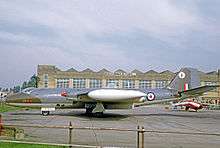No. 58 Squadron RAF
| No. 58 Squadron | |
|---|---|
| Active |
8 June 1916 (RFC) - 1 February 1920 1 April 1924 – 25 May 1945 1 October 1946 – 1 September 1970 1 August 1973 - 4 June 1976 |
| Country |
|
| Branch |
|
| Motto(s) |
Latin: Alis nocturnis ("On the wings of the night") |
| Battle honours | Western Front, 1918: Somme, 1918: Hindenburg Line: France & Low Countries, 1940: Atlantic, 1939-45: Norway 1940: Fortress Europe, 1940-41: Ruhr, 1940-41: Berlin, 1940-41: German Ports, 1940-41: Biscay Ports, 1941-42: Biscay 1942-44: Arctic, 1942-43: Normandy, 1944: Baltic 1944-45: |
| Commanders | |
| Notable commanders | "Bomber" Harris |
| Insignia | |
| Squadron badge heraldry | On a branch an owl. |
| Squadron codes |
BW Nov 1938 - Sep 1939 GE Sep 1939 - Apr 1943 BY Apr 1943 - May 1945 OT Oct 1946 - Oct 1951 |
No. 58 Squadron was a squadron of the Royal Air Force.
History
No. 58 Squadron was first formed at Cramlington, Northumberland, on 8 June 1916 as a squadron of the Royal Flying Corps.
During World War I it operated initially as an advanced training unit but was mobilised in late 1917 and posted to the Western Front until the end of the war. There from February 1918 it flew F.E.2b's and from September, 1918 Handley Page 0/400's. Its targets included airfields, railway communications, rest billets and troop columns, and during some nine months of operational service it dropped 247 tons of bombs. In 1919 it was moved to Egypt as a training unit and redesignated in February 1920 as No. 70 Squadron
It was reformed in 1924 as a heavy bomber unit on training duties, commanded from 1925 by Squadron Leader Arthur Harris, later Air Marshal "Bomber" Harris.

At the start of World War II 58 Squadron was based at RAF Linton-on-Ouse flying Whitley bombers as part of No. 4 Group RAF in RAF Bomber Command. From October 1939 until February 1940 it was based at RAF Boscombe Down attached to Coastal Command carrying out convoy escort patrols. The squadron then returned in February 1940 to Linton-on-Ouse as part of Bomber Command and remained there for the next two years, undertaking its first bombing raid on 17 April 1940. In April 1942 until the autumn of 1944 it again returned to Coastal Command, based at RAF St Eval as part of No. 19 Group RAF. This time it operated as an anti-submarine squadron, converted to the Halifax bomber. For most of this period the squadron operated over the Western Approaches but then moved north to RAF Stornoway in Scotland as part of No. 18 Group RAF. In October 1944 the squadron switched from anti-submarine duties to anti-shipping duties, carrying out attacks on German shipping off the coast of Norway. It was disbanded on 25 May 1945.

In October 1946, No. 58 reformed at RAF Benson in the photo-reconnaissance role, mainly operating Mosquitoes. In March 1953 the squadron re-equipped with Canberra PR.3s and moved to RAF Wyton. These were replaced by Canberra PR.7s in 1955 which took part in the Operation Grapple hydrogen bomb tests at Christmas Island in the Pacific, and also were deployed to British Honduras to face a threat by Guatemala to overfly the country during an official visit by HRH Princess Margaret.[1] The squadron disbanded on 30 September 1970.
It was lastly reformed at RAF Wittering in 1973 as a ground-attack training unit equipped with Hawker Hunters before being finally disbanded in 1976.
References
- ↑ "58 Sqn Aircrew page". Archived from the original on 2012-07-22.
External links
| Wikimedia Commons has media related to No. 58 Squadron RAF. |